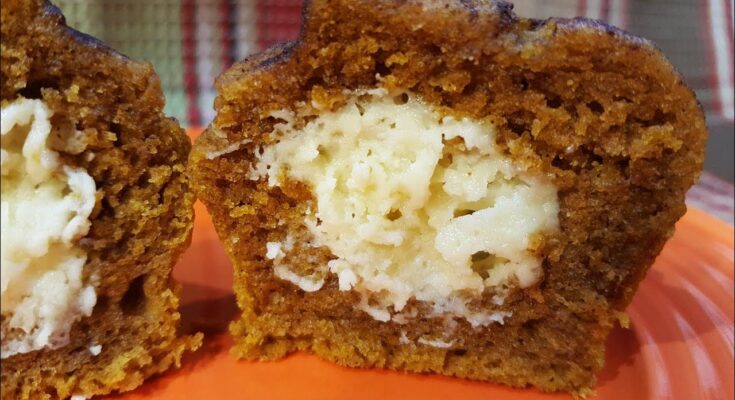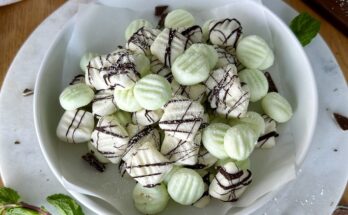Cream Cheese Filling Recipe: Cream cheese filling is one of those versatile recipes every baker should have in their toolbox. Whether you’re making cakes, cupcakes, pastries, or even pancakes, this smooth and tangy filling adds a rich layer of flavor that instantly elevates any dessert. Unlike heavy buttercreams or overly sweet icings, cream cheese filling strikes a perfect balance—it’s creamy, slightly tangy, and not overpoweringly sweet. That’s why it’s loved by home bakers and professional pastry chefs alike.
You’ve probably tasted cream cheese filling in carrot cake, red velvet cake, or stuffed pastries. But here’s the beauty of this recipe: it can be customized in endless ways. Want a fruity twist? Add strawberry puree. Need something richer? Mix in chocolate. Prefer it light and airy? Whip it a bit longer for a fluffier texture.
In this guide, I’ll walk you step by step through the process of making the perfect cream cheese filling. We’ll cover everything from the ingredients you need, to the tools that make the job easier, and finally, the exact process for achieving that smooth, dreamy consistency every single time.
Ingredients You’ll Need
The beauty of cream cheese filling is its simplicity—you only need a few ingredients, but they must be high quality to get the best results. Here’s what you’ll need:
- Cream cheese (full-fat works best for richness)
- Powdered sugar (for sweetness and smooth texture)
- Unsalted butter (softened, for added creaminess)
- Vanilla extract (for flavor balance)
- A pinch of salt (optional, to enhance flavor)
Now, let’s talk about substitutions. If you’re dairy-free, you can use vegan cream cheese made from cashews or coconut. Powdered sugar can be swapped with stevia or erythritol for a sugar-free version. Don’t have butter? Margarine or coconut oil can work in a pinch, though they slightly change the flavor.
When shopping for ingredients, always check the freshness. Fresh cream cheese should be soft, smooth, and free of sour odors. For vanilla extract, go for pure vanilla instead of artificial essence—it makes a noticeable difference in flavor.
Essential Kitchen Tools
Making cream cheese filling doesn’t require fancy equipment, but having the right tools makes the process smoother. At minimum, you’ll need:
- Mixing bowls – Glass or stainless steel bowls are best for mixing.
- Electric hand mixer or stand mixer – You can use a whisk, but for best results, an electric mixer ensures creaminess.
- Measuring cups and spoons – Accuracy matters in baking.
- Rubber spatula – For scraping the sides and making sure no mixture goes to waste.
If you’re serious about baking, investing in a stand mixer can be a game changer. It saves time and gives you the smoothest results with minimal effort. However, if you’re making a small batch, a hand mixer or even a sturdy whisk works just fine.
Step-by-Step Guide to Making Cream Cheese Filling
Step 1: Preparing the Cream Cheese
Take your cream cheese out of the refrigerator at least 30 minutes before you start. Room-temperature cream cheese blends much better and prevents lumps. Cold cream cheese is harder to work with and can make the mixture grainy.
Step 2: Adding Sugar and Sweeteners
Once your cream cheese is softened, beat it in a bowl until smooth. Gradually add powdered sugar while mixing. Adding it slowly helps avoid clumps and ensures even sweetness. Start with less sugar, then taste and adjust based on your preference.
Step 3: Balancing Flavor with Vanilla or Lemon
This is where the magic happens. Add a teaspoon of vanilla extract for that warm, comforting aroma. If you want a slightly fresher flavor, a few drops of lemon juice can cut through the richness and add brightness.
Step 4: Adjusting Texture (Thick vs. Smooth)
If you want a thicker filling for cake layers, add more powdered sugar. For a lighter, fluffier texture, beat the mixture longer to incorporate more air. You’re in control of how dense or airy it turns out.
Step 5: Final Mixing Techniques
Give the filling one final mix until it’s smooth and glossy. Use a spatula to scrape down the sides and make sure everything is well combined. At this stage, your cream cheese filling should be silky, spreadable, and ready to use.
Tips for Perfect Cream Cheese Filling
Even though this recipe is straightforward, a few tips can make your filling foolproof:
- Always use room-temperature cream cheese and butter for smooth blending.
- Don’t overmix—while mixing is important, overdoing it can make the filling too runny.
- If your filling is too soft, chill it in the refrigerator for 15–20 minutes before using.
- Taste and adjust sweetness gradually—you can always add more sugar, but you can’t take it out.
- For extra depth, consider adding a pinch of salt. It balances out the sweetness beautifully.
Mastering these little tricks will ensure that your cream cheese filling always comes out perfect, whether you’re using it in cakes, pastries, or as a dip for fruit.
Variations of Cream Cheese Filling
One of the best things about cream cheese filling is its adaptability. Once you’ve mastered the classic version, you can start experimenting with exciting flavors to suit different desserts or personal preferences. Think of the base recipe as your blank canvas—it’s delicious on its own, but with a few tweaks, you can create something extraordinary.
1. Chocolate Cream Cheese Filling
If you’re a chocolate lover, this variation will make your taste buds sing. Simply blend in melted semi-sweet chocolate or cocoa powder with your cream cheese filling. This creates a luscious, rich, chocolatey spread that pairs perfectly with chocolate cakes, brownies, or even donuts. For extra indulgence, a touch of espresso powder enhances the chocolate flavor even more.
2. Strawberry or Fruit-Infused Cream Cheese Filling
Fruity cream cheese fillings add freshness and color to desserts. You can achieve this by mixing in fruit purees like strawberry, raspberry, or blueberry. If you want a chunkier texture, fold in small fruit pieces at the end. These fruity variations are amazing for summer cakes, tarts, or as a filling for crepes. Just remember to strain purees well to avoid excess liquid that could thin out the filling.
3. Savory Cream Cheese Filling
Yes, cream cheese filling isn’t limited to sweet recipes. You can also go savory! Add herbs like chives, dill, or parsley along with a pinch of garlic powder and black pepper. This savory version works wonderfully as a filling for bagels, savory pastries, or even stuffed vegetables like peppers or cucumbers.
Experimenting with flavors doesn’t just expand your recipe collection—it also allows you to customize desserts for different occasions. Whether you’re making a decadent chocolate-filled cake, a fruity summer tart, or a savory snack, these variations keep things exciting.
Common Mistakes and How to Fix Them
Even though cream cheese filling is fairly simple to make, mistakes can happen—especially if you’re new to baking. The good news is that most of these mistakes are easy to fix with a few tricks.
1. Lumpy Filling
This usually happens if the cream cheese is too cold when you start mixing. The fix? Make sure your cream cheese is softened at room temperature before you begin. If you already have lumps, try beating the mixture longer or passing it through a fine mesh sieve for a smoother texture.
2. Too Runny Filling
If your filling turns out watery or too soft, it’s often because of overmixing or adding too much liquid flavoring. To fix this, add more powdered sugar gradually until it thickens. You can also refrigerate the filling for 20–30 minutes to help it firm up.
3. Too Sweet or Too Tangy
Sometimes, the balance between tanginess and sweetness is off. If your filling is too sweet, a squeeze of lemon juice can cut through the sugar. If it’s too tangy, add a little extra powdered sugar to mellow it out.
4. Overmixing the Filling
Mixing is necessary, but too much of it can break down the structure, making the filling soupy. To prevent this, mix just until smooth and creamy—no more.
Mistakes happen to everyone, even seasoned bakers, but the beauty of cream cheese filling is that it’s forgiving. With these quick fixes, you can turn a potential disaster into a delicious dessert.
Storage and Shelf Life
Once you’ve made your cream cheese filling, proper storage is crucial for freshness and food safety. Unlike buttercream, cream cheese filling is perishable and must be stored correctly.
- Refrigeration: Always store cream cheese filling in an airtight container in the fridge. It typically lasts for up to 5 days without losing flavor or texture. Before using again, let it soften slightly at room temperature so it’s easier to spread.
- Freezing: If you want to prepare ahead, you can freeze cream cheese filling for up to 2 months. To do this, place it in a freezer-safe container, press a piece of plastic wrap over the top to prevent ice crystals, then seal tightly. When you’re ready to use it, thaw overnight in the fridge and whip it briefly to restore its creamy texture.
- Signs of Spoilage: If you notice an off smell, discoloration, or watery separation that can’t be fixed with mixing, it’s time to discard the filling.
Keeping your filling fresh ensures that your desserts taste their absolute best every time. Whether you’re making it for a big party or just to have on hand for weekend baking, proper storage makes all the difference.
Creative Uses for Cream Cheese Filling
Now that you’ve got your perfect cream cheese filling, let’s talk about how to use it. You’d be surprised at how many ways this creamy mixture can enhance your recipes.
- Cakes and Cupcakes: Spread between layers of a red velvet or carrot cake, or pipe into cupcakes for a surprise center.
- Pastries and Donuts: Use it to fill puff pastries, eclairs, or donuts for a bakery-style treat at home.
- Breakfast Favorites: Add a dollop inside pancakes, waffles, or crepes for a rich, indulgent breakfast.
- Fruit Pairings: Spread on top of fresh fruit tarts, or use as a dip for strawberries and apple slices.
- Cookies and Bars: Sandwich between cookies, swirl into brownies, or layer into bars for extra creaminess.
Think of cream cheese filling as the secret ingredient that transforms ordinary recipes into extraordinary ones. Whether it’s a casual brunch, a holiday dessert table, or a quick family snack, this filling is a game changer.
Cream Cheese Filling for Special Diets
Not everyone can enjoy traditional cream cheese filling as-is, but the good news is that there are alternatives for nearly every dietary need. With a few substitutions, you can create versions that are just as creamy and delicious without compromising flavor.
1. Vegan Cream Cheese Filling
For those avoiding dairy, vegan cream cheese is widely available and works beautifully in this recipe. Brands made from cashews, almonds, or coconut provide a rich base. Simply swap regular cream cheese with a vegan version, use dairy-free butter, and sweeten with powdered sugar or a plant-based alternative. The process stays exactly the same, and the results are just as satisfying.
2. Sugar-Free and Keto-Friendly Options
If you’re cutting back on sugar, opt for powdered erythritol, monk fruit sweetener, or stevia instead of traditional powdered sugar. These alternatives blend smoothly and deliver sweetness without the carbs. Keep in mind that some sweeteners are stronger, so start small and adjust to taste.
3. Gluten-Free Tips
Good news: cream cheese filling is naturally gluten-free! The only thing to watch for is cross-contamination with other ingredients in your kitchen. If you’re making a dessert that combines the filling with baked goods, ensure all flours and flavorings are certified gluten-free.
Adapting cream cheese filling for special diets doesn’t mean sacrificing taste. In fact, many of these alternatives add unique flavor profiles that can make your desserts stand out even more.
Pairing Ideas with Cream Cheese Filling
Cream cheese filling shines brightest when paired with the right desserts and drinks. Think of it as a versatile companion that can adapt to different occasions and flavor themes.
- Best Desserts to Pair: Carrot cake, red velvet cake, pumpkin rolls, and cinnamon rolls are classic pairings. The tanginess of the filling cuts through the richness of these bakes perfectly.
- Pastries and Breads: Danish pastries, croissants, and brioche rolls become irresistible when stuffed with cream cheese filling.
- Beverages That Complement It: A strong cup of coffee, a glass of cold milk, or even a spiced chai latte pairs beautifully with cream cheese-filled treats.
- Seasonal Pairings: During fall, pumpkin-flavored desserts with cream cheese filling are unbeatable. In summer, fruity tarts and cheesecakes with cream cheese filling offer refreshing balance.
Pairing is all about contrast and complement. Cream cheese filling is tangy, creamy, and slightly sweet—qualities that make it a natural match for both bold and subtle flavors.
Nutritional Breakdown
Cream cheese filling is undeniably indulgent, but knowing its nutritional content helps you enjoy it mindfully. Here’s a rough estimate per 2-tablespoon serving of traditional cream cheese filling (made with cream cheese, butter, powdered sugar, and vanilla):
| Nutrient | Approximate Value |
|---|---|
| Calories | 120–140 |
| Fat | 9–11g |
| Carbs | 10–12g |
| Protein | 1–2g |
| Sugar | 9–11g |
If you’re looking to lighten things up, here are some simple tweaks:
- Use low-fat cream cheese instead of full-fat.
- Swap powdered sugar with a low-calorie sweetener.
- Skip the butter or replace it with Greek yogurt for a protein boost.
While cream cheese filling may not be the lowest-calorie option, enjoying it in moderation is key. After all, desserts are meant to be a treat, and a little indulgence now and then is perfectly fine.
Expert Tips from Bakers
Professional bakers know a few tricks that make cream cheese filling go from good to unforgettable. Here are some insider secrets:
- Always sift powdered sugar before adding it to the cream cheese. This prevents lumps and ensures a silky finish.
- Use high-quality vanilla extract or even vanilla bean paste for a richer flavor. Artificial vanilla just doesn’t compare.
- Chill before using if you’re piping the filling into cupcakes or pastries. A short refrigeration helps it hold shape better.
- Experiment with add-ins like cinnamon, nutmeg, or citrus zest for unique twists.
- Make small batches fresh when possible. While it stores well, freshly made filling always tastes the best.
These little adjustments can elevate your filling and make your desserts taste like they came straight out of a professional bakery.
FAQs about Cream Cheese Filling Recipe
1. Can I use low-fat cream cheese?
Yes, but the texture won’t be as rich or creamy. For best results, stick with full-fat cream cheese.
2. How do I make it less sweet?
Reduce the powdered sugar and balance with a splash of lemon juice or extra vanilla extract.
3. Can I make it ahead of time?
Absolutely. Cream cheese filling can be stored in the refrigerator for up to 5 days or frozen for up to 2 months.
4. How do I thicken runny filling?
Add more powdered sugar a little at a time, or refrigerate for 20 minutes before use.
5. What desserts work best with it?
Cakes, cupcakes, pastries, donuts, pancakes, waffles, and even fresh fruit pair beautifully with cream cheese filling.
Conclusion
Cream cheese filling is one of those timeless recipes that every baker should master. It’s versatile, easy to make, and brings a tangy richness that elevates desserts from ordinary to extraordinary. With just a few basic ingredients, you can whip up a creamy filling that works for cakes, pastries, and even savory snacks.
What makes it even more exciting is the ability to customize—whether you want chocolate, fruit, or a lighter, healthier version, the options are endless. By following the step-by-step guide and keeping the tips in mind, you’ll always end up with smooth, flavorful cream cheese filling that’s ready to impress.
So next time you’re baking, don’t just stop at the cake or pastry itself—give it the perfect partner in cream cheese filling. It might just become your go-to recipe for every special occasion.



